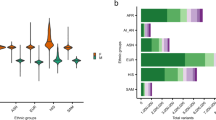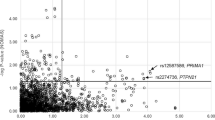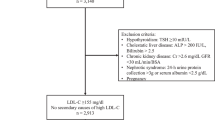Abstract
A low level of high density lipoprotein (HDL) cholesterol is a strong predictor of ischaemic heart disease (IHD) and myocardial infarction1,2,3. One cause of low HDL-cholesterol is Tangier disease (TD), an autosomal codominant inherited condition first described in 1961 in two siblings on Tangier Island in the United States of America4. Apart from low HDL-cholesterol levels and an increased incidence of atherosclerosis5, TD is characterized by reduced total cholesterol, raised triglycerides, peripheral neuropathy and accumulation of cholesteryl esters in macrophages, which causes enlargement of the liver, spleen and tonsils4,6. In contrast to two other monogenic HDL deficiencies in which defects in the plasma proteins apoA-I and LCAT interfere primarily with the formation of HDL (refs 7, 8, 9, 10), TD shows a defect in cell signalling and the mobilization of cellular lipids11,12,13,14. The genetic defect in TD is unknown, and identification of the Tangier gene will contribute to the understanding of this intracellular pathway and of HDL metabolism and its link with IHD. We report here the localization of the genetic defect in TD to chromosome 9q31, using a genome-wide graphical linkage exclusion strategy in one pedigree, complemented by classical lod score calculations at this region in a total of three pedigrees (combined lod 10.05 at D9S1784). We also provide evidence that TD may be due to a loss-of-function defect.
This is a preview of subscription content, access via your institution
Access options
Subscribe to this journal
Receive 12 print issues and online access
$209.00 per year
only $17.42 per issue
Buy this article
- Purchase on Springer Link
- Instant access to full article PDF
Prices may be subject to local taxes which are calculated during checkout



Similar content being viewed by others
References
Miller, N.E., Thelle, D.S., Forde, O.H. & Mjos, O.D. The Tromsö heart-study. High-density lipoprotein and coronary heart-disease: a prospective case-control study. Lancet 1, 965–968 (1977).
Gordon, T., Kannel, W.B., Castelli, W.P. & Dawber, T.R. Lipoproteins, cardiovascular disease, and death. The Framingham study. Arch. Intern. Med. 141, 1128–1131 (1981).
Assmann, G. & Schulte, H. PROCAM-trial. (Panscientia Verlag, Hedingen, Zürich, 1986).
Fredrickson, D.S., Altrocchi, P.H., Avioli, L.V., Goodman, D.S. & Goodman, H.C. Tangier disease: Combined clinical staff conference at the National Institute of Health. Ann. Intern. Med. 55, 1016–1031 (1961).
Serfaty-Lacrosniere, C. et al. Homozygous Tangier disease and cardiovascular disease. Atherosclerosis 107, 85–98 (1994).
Assmann, G., von-Eckardstein, A. & Brewer, H.B. Jr. Familial high density lipoprotein deficiency: Tangier Disease. in The Metabolic and Molecular Basis of Inheritied Disease. (eds Scriver, C.R., Beaudet, A.L., Sly, W.S. & Valle, D.) 2053–2072 (McGraw-Hill, New York, 1995).
Karathanasis, S.K., Ferris, E. & Haddad, I.A. DNA inversion within the apolipoproteins AI/CIII/AIV-encoding gene cluster of certain patients with premature atherosclerosis. Proc. Natl Acad. Sci. USA 84, 7198–7202 (1987).
Funke, H. et al. A frameshift mutation in the human apolipoprotein A-I gene causes high density lipoprotein deficiency, partial lecithin: cholesterol-acyltransferase deficiency, and corneal opacities. J. Clin. Invest. 87, 371–376 (1991).
Funke, H. et al. A molecular defect causing fish eye disease: an amino acid exchange in lecithin-cholesterol acyltransferase (LCAT) leads to the selective loss of alpha-LCAT activity. Proc. Natl Acad. Sci. USA 88, 4855–4859 (1991).
Funke, H. et al. Genetic and phenotypic heterogeneity in familial lecithin: cholesterol acyltransferase (LCAT) deficiency. Six newly identified defective alleles further contribute to the structural heterogeneity in this disease. J. Clin. Invest. 91, 677–683 (1993).
Walter, M., Gerdes, U., Seedorf, U. & Assmann, G. The high density lipoprotein- and apolipoprotein A-I-induced mobilization of cellular cholesterol is impaired in fibroblasts from Tangier disease subjects. Biochem. Biophys. Res. Commun. 205, 850–856 (1994).
Francis, G.A., Knopp, R.H. & Oram, J.F. Defective removal of cellular cholesterol and phospholipids by apolipoprotein A-I in Tangier Disease. J. Clin. Invest. 96, 78–87 (1995).
Rogler, G., Trumbach, B., Klima, B., Lackner, K.J. & Schmitz, G. HDL-mediated efflux of intracellular cholesterol is impaired in fibroblasts from Tangier disease patients. Arterioscler. Thromb. Vasc. Biol. 15, 683–690 (1995).
Walter, M. et al. Defective regulation of phosphatidylcholine-specific phospholipases C and D in a kindred with Tangier disease. Evidence for the involvement of phosphatidylcholine breakdown in HDL-mediated cholesterol efflux mechanisms. J. Clin. Invest. 98, 2315–2323 (1996).
Assmann, G., Simantke, O., Schaefer, H.-E. & Smootz, E. Characterization of high density lipoproteins in patients heterozygous for Tangier disease. J. Clin. Invest. 60, 1025–1035 (1977).
Puffenberger, E.G. et al. Identity-by-descent and association mapping of a recessive gene for Hirschsprung disease on human chromosome 13q22. Hum. Mol. Genet. 3, 1217–1225 (1994).
Houwen, R.H.J. et al. Genome screening by searching for shared segments: mapping a gene for benign recurrent intrahepatic cholestasis. Nature Genet. 8, 380–386 (1994).
Nikali, K. et al. Random search for shared chromosomal regions in four affected individuals: the assignment of a new hereditary ataxia locus. Am. J. Hum. Genet. 56, 1088–1095 (1995).
Lander, E. & Kruglyak, L. Genetic dissection of complex traits: guidelines for interpreting and reporting linkage results. Nature Genet. 11, 241–247 (1995).
Risch, N. A note on multiple testing procedures in linkage analysis. Am. J. Hum. Genet. 48, 1058–1064 (1995).
Kroes, H.Y., Tuerlings, J.H.A.M., Hordijk, R., Folkers, N.R.P. & ten Kate, L.P. Another patient with an interstitial deletion of chromosome 9: case report and a review of six cases with del(9)(q22q32). J. Med. Genet. 31, 156–158 (1994).
Dib, C. et al. A comprehensive genetic map of the human genome based on 5,264 microsatellites. Nature 380, 152–154 (1996).
Lathrop, G.M., Lalouel, J.M., Julier, C. & Ott, J. Strategies for multilocus linkage analysis in humans. Proc. Natl Acad. Sci. USA 81, 3443–3446 (1984).
Cottingham, R.W., Jr., Idury, R.M. & Schaffer, A.A. Faster sequential genetic linkage computations. Am. J. Hum. Genet. 53, 252–263 (1993).
Lander, E.S. & Schork, N.J. Genetic dissection of complex traits. Science 265, 2037–2048 (1994).
Acknowledgements
We thank all patients and their family members for their cooperation. This project was sponsored in part by a grant from Interdisziplinäres Klinisches Forschungszentrum der Universität Münster to H.F. (project grant A5). We thank M. Farrall, for critical reading of our manuscript.
Author information
Authors and Affiliations
Corresponding author
Rights and permissions
About this article
Cite this article
Rust, S., Walter, M., Funke, H. et al. Assignment of Tangier disease to chromosome 9q31 by a graphical linkage exclusion strategy. Nat Genet 20, 96–98 (1998). https://doi.org/10.1038/1770
Received:
Accepted:
Issue Date:
DOI: https://doi.org/10.1038/1770
This article is cited by
-
ABCA1, from pathology to membrane function
Pflügers Archiv - European Journal of Physiology (2007)
-
ATP-binding cassette (ABC) transporters in atherosclerosis
Current Atherosclerosis Reports (2002)
-
Perspectives for vascular genomics
Nature (2000)



